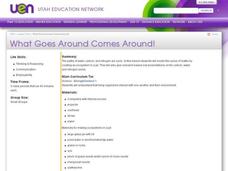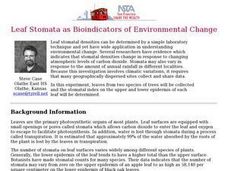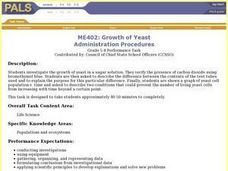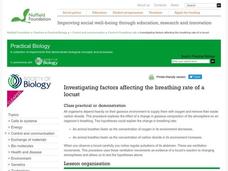Carbon Teacher Resources
Find Carbon lesson plans and worksheets
Showing 3,832 resources
Curated OER
What Goes Around Comes Around!
Students create an ecosystem in a jar to show a model of the water, carbon, and nitrogen cycle. Working in small groups, they research and present orally the information they find on this cycle.
Curated OER
Leaf Stomata as Bioindicators of Environmental Change
High schoolers perform an experiment to determine the stomaltal index on the upper and lower epidermis of two species of leaves. Stomatal densities change in response to changing atmospheric levels of carbon dioxide and to annual rainfall.
Curated OER
Photosynthesis: A Controlled Experiment
Students investigate the amount of starch in a plant under 3 different conditions. In this photosynthesis lesson plan, students compare the amount of starch in a plant with increased carbon dioxide conditions, a plant with decreased...
Curated OER
Geologic Sequestration
Students investigate how geologic sequestration reduces carbon dioxide concentration in the atmosphere. In this earth science lesson, students simulate oil mining in the lab. They write down their observations and complete the lab report...
Curated OER
How Does the Loss of Ozone Affect Our Climate
Young scholars explore the greenhouse effect and what it does to the environment. They discuss if and how human behavior contributes to global warming and test natural materials for carbon content.
Curated OER
Changes in Nature
Fifth graders identify the chemical and physical changes in the water cycle, carbon cycle, and the effects of weathering. They analyze the periodic table, and observe how vinegar reacts with limestone in a chemical reaction that causes...
Curated OER
Cell Energy - Bubbling Yeast
Middle schoolers identify that yeast are a single celled fungi that are a great model organism for studying respiration in the classroom. They also fill the bulb of a disposable pipet (eyedropper) with yeast, then submerge the pipet in...
Curated OER
ME402: Growth of Yeast
Students investigate the growth of yeast in a sugar solution. They verify the pressure of carbon dioxide using bromothymol blue. Students are asked to describe the difference between the contents of the test tubes used and to explain...
Curated OER
Photosynthesis
Students investigate photosynthesis in water plants. In this photosynthesis lesson plan, students use the elodea plant and observe gas bubbles released to determine the rate of photosynthesis. They vary the light intensity and the amount...
Curated OER
Life in the Soil - Is the Soil Alive?
Amaze soil scientists with a list of the myriad of microorganisms residing in a mere 1/4 teaspoon of soil! Then take them on a ride through the carbon cycle, down to the level of decomposers. Finally, give more specific details about the...
Curated OER
Tread Lightly: Low Carbon Lunch
Students create a flowchart of the carbon footprint of food from production to disposal. In this biology lesson, students brainstorm ways to reduce greenhouse gases by smart food choices. They create a blog promoting ways to eat low...
Montana State University
Climb into Action!
Climate change affects even the largest and intimidating of landforms—even Mount Everest! A resource helps teach learners the connection between global climate change and its effects on Earth. Activities include videos, class discussion,...
NOAA
Ocean Acidification
If tap water is more acidic than ocean water, why are we so concerned about ocean acidification? The third installment of a 23-part NOAA Enrichment in Marine sciences and Oceanography (NEMO) program focuses on carbon dioxide levels in...
California Academy of Science
Buses and Biofuels: Sustainable Transportation
One-third of all carbon emissions comes from transportation in the United States. The third lesson in a 13-part series on Exploring Energy offers ideas on how to reduce emissions from cars, airplanes, large trucks, and more.
American Museum of Natural History
Atomic Mobile
Structure an activity around atoms. Learners use their knowledge of the parts of atoms—the protons, neutrons, and electrons—to build a model of a carbon atom. Scholars create a nucleus by using clay balls to represent the protons and...
Chicago Botanic Garden
Greenhouse Gas Emissions – Natural and Human Causes
Part three in the series of seven has pupils discussing the different greenhouses gases, learning about the carbon cycle, and then watching a short video about the carbon cycle. Based on their knowledge, individuals complete a greenhouse...
Nuffield Foundation
Investigating Factors Affecting the Breathing Rate of a Locust
Do animals breathe faster when given more oxygen or more carbon dioxide? Young scientists observe the respiration rates of locusts under a variety of gas concentrations to answer that very question. They collect data, analyze the...
Bozeman Science
Biogeochemical Cycling
A woman had a job crushing cans at the recycling plant; it was soda pressing. Video focuses on the ways our environment recycles, including the water cycle, carbon cycle, nitrogen cycle, and the phosphorus cycle. It also describes the...
Socratica
Chemistry: Average Atomic Mass (AMU, Daltons, etc.)
Scientists created a new measurement, the atomic mass unit, which is defined as carbon 12 = 12amu. So why isn't carbon listed as having exactly 12 amu on the periodic table? An installment from the Socratica chemistry playlist answers...
NOAA
I Didn’t Do It…Did I?: Make Your Own Greenhouse Effect
How do greenhouse gases affect the climate on Earth? Pupils explore the concept by first building their own apparatuses to model the greenhouse effect. Then, they record data to measure temperature change and determine...
Crash Course
Circulatory and Respiratory Systems
Viewers follow the paths of oxygen and carbon dioxide through the human respiratory organs and the path of the molecules through the human circulatory system, in a short video about how the body delivers oxygen and picks up...
Chicago Botanic Garden
Personal Choices and the Planet
The last activity in the series of four has individuals determine steps they can take to reduce their carbon footprints and then analyze their schools' recycling programs. Through a sustainability audit, they identify how and where their...
Chicago Botanic Garden
Climate Change Around the World
It is unknown if cloud cover increases in response to carbon dioxide levels changing, helping climate change slow down, or if cloud cover decreases, allowing Earth to warm faster. Part four in the series of five lessons has classes...
Chicago Botanic Garden
Historical Climate Cycles
Scientists use ice core samples to obtain temperatures of the earth from 400,000 years ago! The third of five lessons instructs pupils to interpret historical climate data to see changes over time. In part I, participants interpret...
Other popular searches
- Carbon Cycle
- Carbon Footprint
- Carbon Dioxide
- Carbon Dioxide Oxygen Cycle
- Carbon Cycle Diagram
- Carbon Cycle Powerpoint
- Carbon Dioxide Cycle
- Calcium Carbonate
- Carbon Dating
- Carbon Cycle Activities
- Nitrogen and Carbon Cycle
- Carbon Cycle Lesson Plans

























